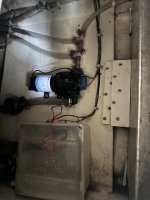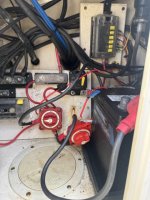C-Wolfe
Member
- Joined
- Sep 16, 2020
- Messages
- 351
- Reaction score
- 0
- Location
- Anchorage
- C Dory Year
- 2008
- C Dory Model
- 255 Tomcat
- Vessel Name
- Valhalla
I will be moving my house battery bank to inside the cabin, my first thought was to move it inside the galley cabinet. The cabinet is quite deep and loosing some storage room in the very back might not be such a big deal after all, but that is still loosing some valuable storage room. My second option is to move the batteries to inside the pontoon, I have an access hatch to access the water pump and sump box. I already replace it for a smaller one to help make room for the batteries in the back of the cabinet, this can easily be undone and put the original hatch back in

I can move the water pump as far outboard as possible, as for the sump box, the shower was move to the cockpit and I just remove the water heater, so I can get that out, at least for now. If I need it back in the future, I can find a different location for it.

That location put the battery right next to the starboard fuel tank, I’m not too crazy about that, is that a legitimate concern or not? This is the main reason I’m reaching out to the C-Brats community right now. On my CD22, the batteries where very close to the fuel tanks as I think many others, but it still feel different then inside the pontoon of the tomcat.
So here is the full picture. I will be adding 2 Victron 18 amps dc to dc charger (one from each start battery), I currently have 2 AGM 100 AH group 31, I will keep them as long as they perform good but will consider switching to lithium when time comes to replace my house bank. I have a few switches, fuse block, beaker box in the cockpit lazaret the have a good amount of corrosion, I would like to move as much of those inside the cabin/galley cabinet as I can. That will hopefully reduce the maintenance on my electrical.


As Always, feel free to poke any holes in my plan and let me know what I might have miss. But as stated above, my main concern is the new battery location.
Thanks for any input .

I can move the water pump as far outboard as possible, as for the sump box, the shower was move to the cockpit and I just remove the water heater, so I can get that out, at least for now. If I need it back in the future, I can find a different location for it.

That location put the battery right next to the starboard fuel tank, I’m not too crazy about that, is that a legitimate concern or not? This is the main reason I’m reaching out to the C-Brats community right now. On my CD22, the batteries where very close to the fuel tanks as I think many others, but it still feel different then inside the pontoon of the tomcat.
So here is the full picture. I will be adding 2 Victron 18 amps dc to dc charger (one from each start battery), I currently have 2 AGM 100 AH group 31, I will keep them as long as they perform good but will consider switching to lithium when time comes to replace my house bank. I have a few switches, fuse block, beaker box in the cockpit lazaret the have a good amount of corrosion, I would like to move as much of those inside the cabin/galley cabinet as I can. That will hopefully reduce the maintenance on my electrical.


As Always, feel free to poke any holes in my plan and let me know what I might have miss. But as stated above, my main concern is the new battery location.
Thanks for any input .

